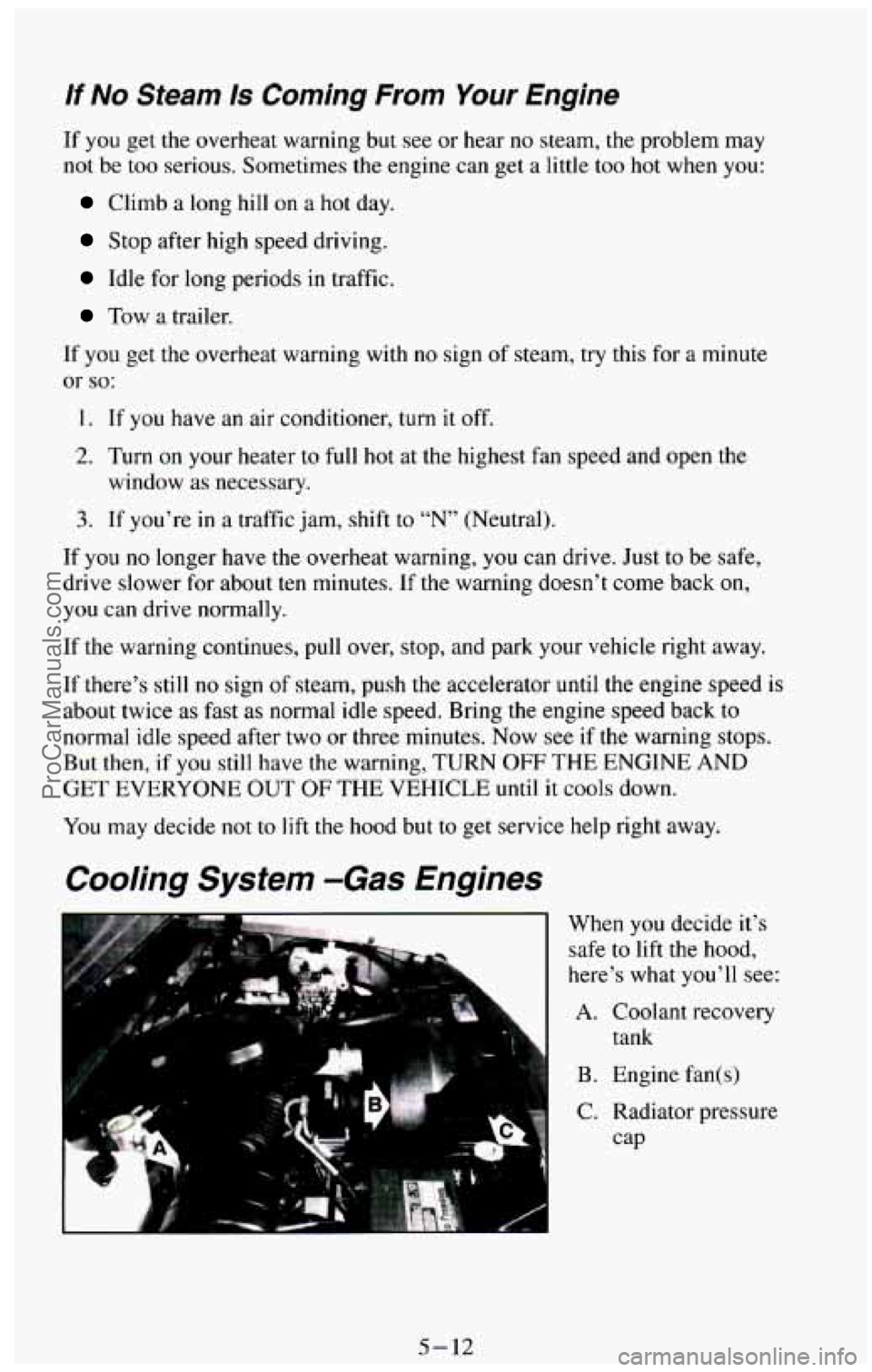Page 215 of 385

If No Steam Is Coming From Your Engine
If you get the overheat warning but see or hear no steam, the problem may
not be too serious. Sometimes the engine can get a little too hot when you:
Climb a long hill on a hot day.
Stop after high speed driving.
Idle for long periods in traffic.
Tow a trailer.
If you get the overheat warning with no sign of steam, try this for a minute
or
so:
1. If you have an air conditioner, turn it off.
2. Turn on your heater to full hot at the highest fan speed and open the
3. If you’re in a traffic jam, shift to “N’ (Neutral).
window
as necessary.
If you
no longer have the overheat warning, you can drive. Just to be safe,
drive slower for about ten minutes. If the warning doesn’t come back on,
you can drive normally.
If the warning continues, pull over, stop, and park your vehicle right away.
If there’s still
no sign of steam, push the accelerator until the engine speed is
about twice as fast as normal idle speed. Bring the engine speed back to
normal idle speed after two or three minutes. Now see
if the warning stops.
But then, if
you still have the warning, TURN OFF THE ENGINE AND
GET EVERYONE OUT OF THE VEHICLE until it cools down.
You may decide not to lift the hood but to get service help right away.
Cooling System -Gas Engines
When you decide it’s
safe to lift the hood,
here’s what you’ll see:
A. Coolant recovery
“I tank
B. Engine fan(s)
C. Radiator pressure
cap
5-12
ProCarManuals.com
Page 219 of 385
How to Add Coolant to the Radiator
1. You can remove the radiator pressure cap when the cooling system,
including
the radiator pressure cap and upper radiator hose, is no longer
hot.
Turn the pressure cap slowly to the left
until it first stops. (Don't press
down while turning the pressure cap.)
If you hear a hiss, wait for that to stop. A hiss means there is still some
pressure left.
2. Then keep
turning the
pressure cap, but
now push down
as you turn it.
Remove the
pressure cap.
5-16
ProCarManuals.com
Page 220 of 385
3. Fill the radiator
with the proper
mix, up to the
base of the filler
neck.
4. Then fill the
coolant recovery
tank to the
COLD mark.
5. Put the cap back
on the coolant
recovery tank,
but leave the radiator pressure
cap off.
5- 17
ProCarManuals.com
Page 221 of 385
6. Start the engine
and let it run until
you can feel the
upper radiator
hose getting hot.
Watch
out for the
engine fan(s).
By this time the coolant level inside the radiator filler neck may be
lower.
If the level is lower, add more of the proper mix through the
filler neck
until the level reaches the base of the filler neck.
8. Then replace the
pressure cap. At
any time during
this procedure
if
coolant begins to
flow out of the
filler neck,
reinstall the
pressure cap. Be
sure the arrows
on pressure cap
line up
like this.
Cooling System -Diesel Engines
When you decide it's
safe
to lift the hood,
here's what
you'll see:
A
A. Coolant surge
tank pressure cap
B. Engine fan(s)
C. Radiator
5-18
ProCarManuals.com
Page 224 of 385
NOTICE:
In cold weather, water can freeze and crack the engine, radiat\
or,
heater core and other parts.
So use the recommended coolant.
1. You can remove the coolant surge tank pressure cap when the cooling
system, including the coolant surge tank pressure cap and upper
radiator
hose, is no longer hot.
5-21
ProCarManuals.com
Page 226 of 385
While filling the surge tank, watch to see if coolant begins to stream out
the air bleed valve. When coolant begins to stream out, close the valve.
5. With the air bleed
valve closed and
the coolant surge
tank pressure cap
off, start the
engine and let
it
run until you can
feel
the upper
radiator hose
getting hot.
Watch out for the
engine fan(
s).
6. By this time, the coolant level inside the coolant surge tank may be
lower.
If the level is lower, add more of the proper mix to the coolant
surge tank until the level reaches the
COLD mark.
7. Then replace the
pressure cap.
Be
sure the arrows
on the pressure
cap line up like
this.
5-23
ProCarManuals.com
Page 284 of 385
Radiator Pressure Cap-Gas Engines
I I
The radiator pressure
cap must be tightly
installed with the
arrows on the cap
lined up with the
ovefflow tube on the
radiator filler neck.
NOTICE:
Your radiator cap is a 15 psi (105 kPa) pressure-type cap and
must be tightly installed
to prevent coolant loss and possible
engine damage from overheating. Be sure the arrows on the cap
line up with the overflow tube on the radiator filler neck.
ProCarManuals.com
Page 285 of 385
Surge Tank Pressure Cap- Diesel Engines
The surge tank
pressure cap must be
tightly installed with
the arrows
on the cap
lined up with the top
tube
of the coolant
surge tank.
NOTICE:
Your surge tank pressure cap 1s a unique 15 psi (105 kPa)
pressure-type cap for use with surge tank cooling systems only.
It must be tightly installed to prevent coolant loss and possible
engine damage from overheating. Be sure the arrows on the cap
line up with the top tube
of the coolant surge tank.
Thermostat
Engine coolant temperature is controlled by a thermostat in the engine
coolant system. The thermostat stops the flow
of coolant through the
radiator until the coolant reaches a preset temperature.
When you replace your thermostat, an
AC@ thermostat is recommended.
Power Steering Fluid
I NOTICE:
Always turn the engine off before checking or adding power
steering
fluid. The power steering pump cap is close to the fan
and other moving parts.
6-40
ProCarManuals.com